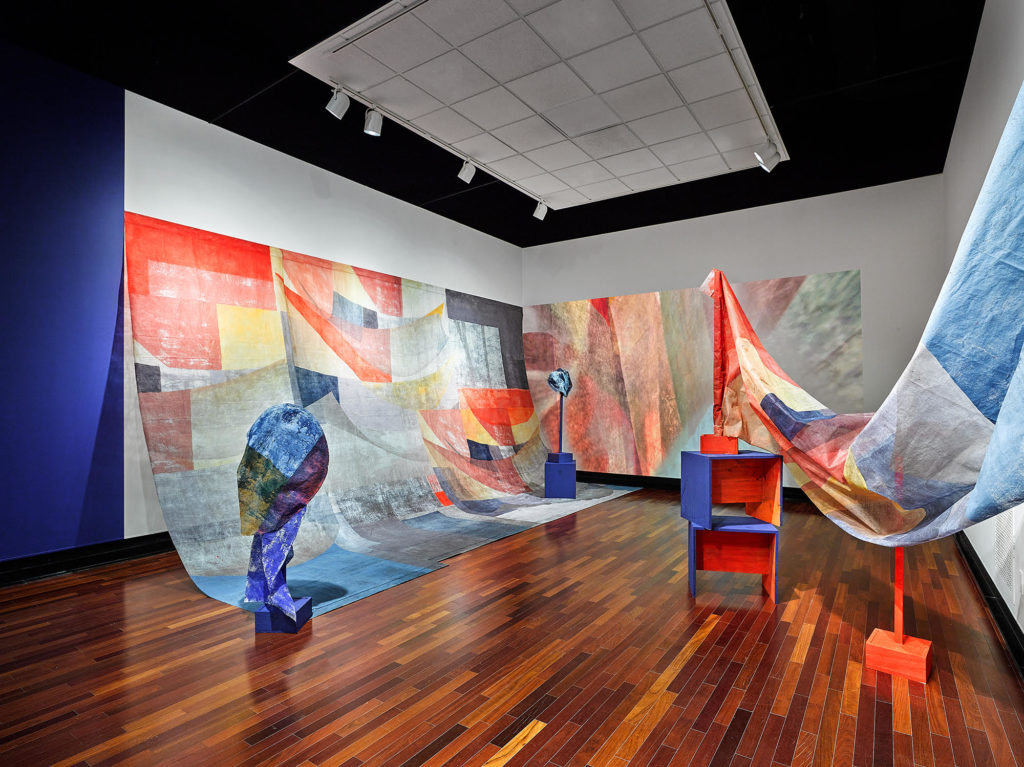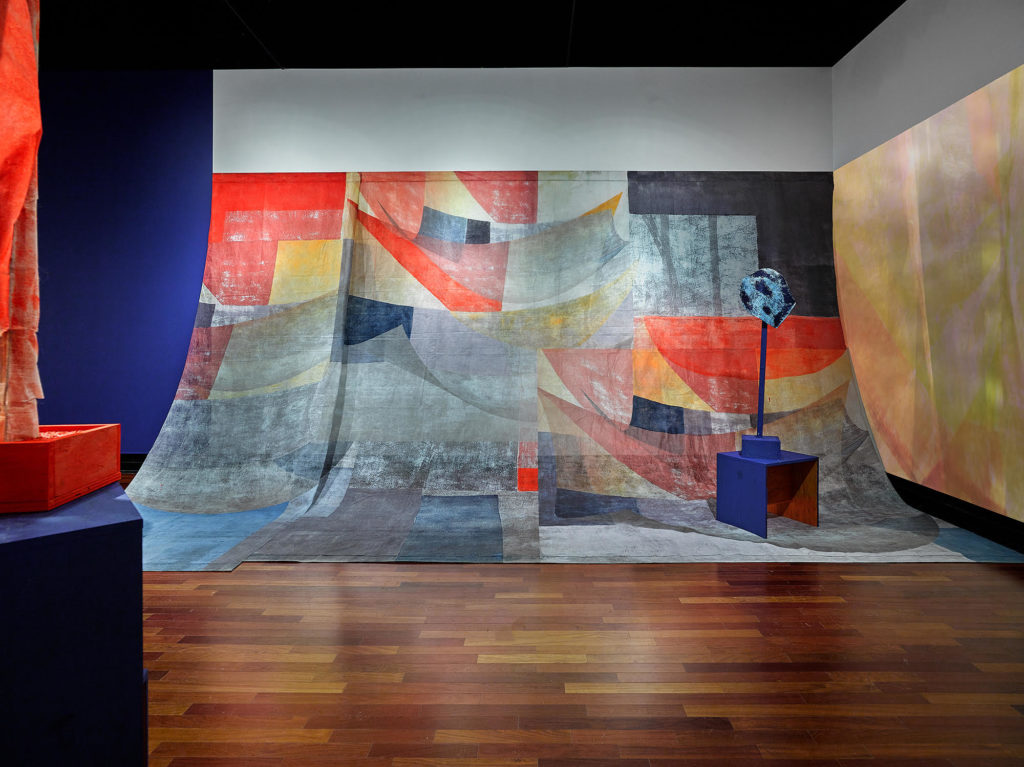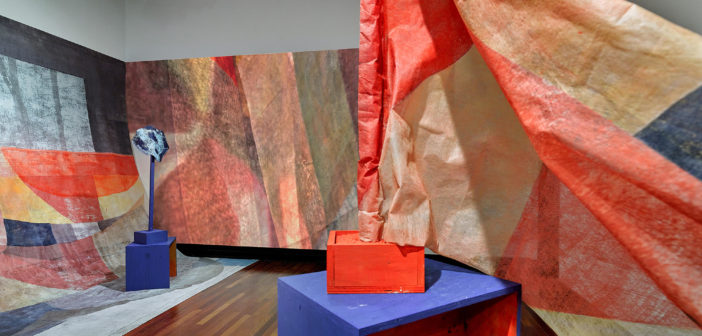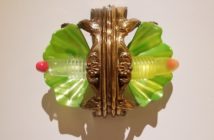Anna Kunz’s Venus harbors classical ambitions—not only in its name’s obvious mythological reference but in its sweeping aspirations toward spatial, painterly beauty. It was apropos then that during my visit to Providence College’s Reilly Gallery, a band recital could be overheard from the adjacent auditorium. The swell and crescendo of the instruments synchronized with the exhibit’s vortex of a centerpiece: a large video projection on the wall that pushes viewers into a chromatic tunnel of fabric folds.
“Explain why my mattress/Feels so hard, and the bedclothes will never stay in place?” wonders a restless Ovid in Amores.
Venus could be the poet’s bedroom, albeit redecorated. Like the mattress, the art of painting has become stiff, and the linens are increasingly recalcitrant, acrobatic. The Chicago-based Kunz makes plenty of ‘regular’ paintings, but Venus is not one of them. This installation is rather an extended love poem to painting and its process.
Kunz’s reincarnation swaps Venus’ gendered persona for an ethereal one, but the goddess’ sine qua non of sexuality emerges in the very architecture: paintings unfurl to the floor, a wall becomes a pool of light, and sheer canvases contort as they try a new position—this kinky thing called ‘sculpture.’
Venus is best understood as a cohesive set of variations on a theme, with each painting/sculpture hybrid a transposition of the same idea. There are four sculptures, a big painting on gauze scrims, and the hypnotic, living canvas of the aforementioned video. There’s also a small work on paper from 2016, framed and mounted on the wall near the entrance. While ordinary against the surrounding grandeur, the tiny painting (this Venus’ clamshell, one supposes) does contain the rudiments of the current installation: translucency, blocky formations of red and blue, and watery brushwork.
How does material affect color’s expression? How does color manifest in space? These seem prominent concerns of Venus, which rephrases a traditional question of painting—how do colors interact?—from surfaces to dimensions.
Venus relies heavily on red, blue and yellow, all employed by Kunz with harmony and playfulness. In the scrims, the color phases in and out of tangibility, and dives into gray tones that interrupt the painting’s bright song with passages of restful silence. Another pole-attached scrim stands atop two boxes and connects to the opposite wall, its painted surface hanging in a graceful stretch reminiscent of Sam Gilliam’s bunched-together rainbows. A sculpture on the floor unrolls a strip of blue over a concealed box, its head crowned by a red elliptical shape that taunts the viewer like a stuck-out tongue.

Installation view of “Anna Kunz: Venus” at Providence College Galleries, November 30, 2017 - February 24, 2018. Photo: Scott Alario
Is Venus painting or sculpture in the expanded field? It resonates more with the former, which in Gustavo Fares’ evaluation resists the “classical” demand that paintings “cannot have movement nor…be three dimensional in any relevant way, other than by having some thickness in terms of texture.”
Kunz’s work seems to exist in 2 1/2 dimensions. The exhibit requires the same choreography, the rhythmic looking, needed to enjoy sculpture. There is a dance-like flow in the viewer’s navigation of this vibrant playground.
As Venus endeavors to be seen from multiple positions and vantage points, her mythic counterpart was likewise not known for fidelity. Her marriage never consummated, Venus instead birthed a number of children with numerous fathers. This promiscuity is echoed faintly and rather amusingly in Kunz’s use of diverse surfaces and techniques, suggesting that painting, like Venus herself, is not a monogamous being.
These flashes of painterly emancipation suggest that perhaps Kunz hasn’t totally replaced the goddess’ gendered aspect, but rather potentiated it through color, thereby abstracting the Venusian body. Depictions of Venus abound in the history of painting, but these mostly male interpretations often reduce her to a reified feminine ideal. Venus’ aqueous influence over the fire of masculinity, the lyrical violence of her birth (born from pieces of castrated flesh), the power she wields over men and over life itself—these are absent in scores of depictions, from Botticelli’s straightforward The Birth of Venus (1486) to Titian’s Venus of Urbino (1534). Kunz has at least freed the goddess from the problematics of the male gaze, and toward the omnipresence of color.

Installation view of “Anna Kunz: Venus” at Providence College Galleries, November 30, 2017 - February 24, 2018. Photo: Scott Alario
In What Color is the Sacred?, anthropologist Michael Taussig writes that Western culture has long incubated a “chromophobia,” conferring higher status upon whiteness as it “sterilize[s]the extremity of color.” Implicit in “the Western experience of colonization as colored Otherness,” color’s oppression is also found in culture’s more quotidian aspects. Asks Taussig:
Who of you reading this text would even dream of painting the living-room wall bright red or green, or any color other than off-white? Then, safe in your whiteness, you can hang a wildly colored picture on the wall, secure in its framed being.
So where does one locate Venus on the grid of color and anti-color? It clearly shifts toward the former, but Kunz’s palette isn’t loud. The chroma could be pushed skyward, a la high-voltage painters like Trudy Benson, Kristin Baker or Mariah Dekkenga, who all share with Kunz an affinity for jubilant and at times disjointed geometries.
But Kunz might be the wrong artist from whom to anticipate this high-fructose style. Looking over her recent paintings, she seems to prefer selective use of heightened brightness. The sharp yellow triangle in Physical Sunshine (2017) is a good example. Kunz’s chromatic narrative has different aims than the dopamine-jolting palettes of her contemporaries. As a colorist, arrangement, not intensity, is her forte.
Given the installation’s sense of mass and space, Venus succeeds most as a sensual revolt against Taussig’s idea of the “wildly colored picture” sentenced to eggshell interiors. Venus couldn’t be paved to flatness or condensed upon a wall. It’s a public artwork, not only in size but in the sense of needing people for its full animation and becoming. What is Venus without her consorts or adoring fans?
Venus asks the viewer's partnership and movement to activate its drama. Looking at the video projection, I noticed my shadow was recorded by its light, welcomed into its whirlpool of color—a confirmation of Meg Duguid’s claim that Kunz’s installations make one “aware that the body in all of its interpretations is always present.”
Color leads the viewer’s body in Venus. Like bright signage in the commercial landscape, the prismatic lighting of the nightclub, or the boundless color field painting that we call ocean, Venus impels us to keep moving and looking. Thus Kunz conducts a dance, and also an orchestra, not unlike the one whose music seeped through the gallery doors during my visit. Even without that serendipitous soundtrack, Venus evokes an affection, or at least affirmation, for painting’s continued prowess. We’re reminded that color can move our bodies or, better yet, satisfy them. As a concept, Venus confirms that sensuality exists under divine auspice. Kunz’s Venus seemingly agrees. In painting, the body knows what to do.
Anna Kunz's Venus is on view at the Providence College's Reilly Gallery through February 24.




